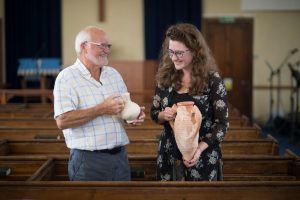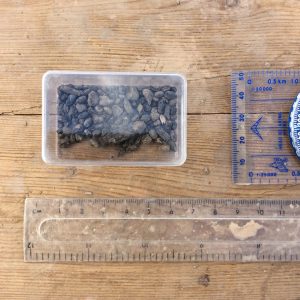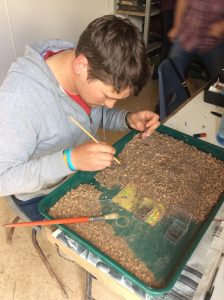
Here’s the second of Sophie’s blog posts. Sophie is our intern who is based at the Hub in Ipplepen Methodist Church weekdays from 10am to 4pm until 29th June 2017. Do drop in to find out more about this year’s excavation.

What can the environment tell us about ancient life at Ipplepen?
The historic landscape is a term used to describe the environment that Ipplepen’s inhabitants would have lived within in the past. There are many ways in which modern archaeologists can attempt to rebuild this environment with one of the most common being to study the remains of agriculture such as seeds from ancient crops and animal bone which have been preserved. Crops, the most common being various kinds of wheat, barley and oats, can be used to shed light on many things in the ancient world. They can be used to show trends in popular foods, tastes and preferences within communities, and even soil conditions and therefore the state of the environment at the time in which they were grown. For example, wheat, though the most common crop is also the least tolerant to poor soil conditions and waterlogging. It is therefore uncommon to find large amounts of it anywhere with thin, or exhausted soil. Barley is a little more tolerant and so may be found in a wider variety of conditions but it is oats, tolerant of both bad soil quality and saline conditions, which can be grown almost anywhere.

Furthermore, each plant had different used with wheat being more in keeping with Roman tastes, barley being used for brewing and oats being used to feed animals. By working out how much land at a given site was dedicated to which crop it is possible to reconstruct what the environment may have looked like at the time but also how much value was placed upon each crop. For instance, wheat (most commonly of the Spelt variety) was common in Roman Britain and seems to have become a Romanised taste. Lastly, charred seeds can be radiocarbon dated and in this way they are very valuable when it comes to establishing the environment chronologically. In a similar manner animal bones, most commonly cow, pig and sheep/goat (sheep and goat are almost indistinguishable from each other archaeologically) can also be used to reconstruct both the ancient environment and life in a broader sense. Like crops they can also be used to show the preferences of a community, the status of a community and whether that community farmed animals for their meat or secondary products (such as wool or milk). However, they also show more obviously to what degree a community has accepted Roman influence into their life style. Roman tastes show a preference for beef and pork as can be seen in high status and military sites. Conversely, sheep/goat seems to indicate a more traditional lifestyle which has not been affected by the presence of the Romans to such a high degree. As such, the consumption of these meats has become an indicator of status and another way in which to reconstruct ancient lives from environmental evidence. However, there are problems when trying to relate this information to Ipplepen specifically. Ipplepen, like the rest of Devon, has quite acidic soil meaning that bones are badly preserved, if
they even survive at all. This makes it difficult to identify them with certainty. Seeds are often only preserved through accidental charring, such as if they were dropped into fire accidentally during cooking. As such it is impossible to be sure just how representative of daily life our assemblages are.
But this doesn’t mean that there has been a lack of environmental data found at the Ipplepen site! Though seeds have been found before on this site it was in 2016 when their collection really took off. Through the painstaking efforts of students and volunteers alike who went through dirt samples by hand (armed only with a paintbrush and a pair of tweezers!) hundreds of examples were found, whilst the excavators carefully removed and bagged all possible animal bone evidence. Though full assemblages from the site are not yet available both wheat and cow bones have been found which carries interesting implications for how Ipplepen fits into the wider Romano-British landscape. If you’re interested in finding out more come and visit the Hub before the 29th of June and bring any questions you have with you!!